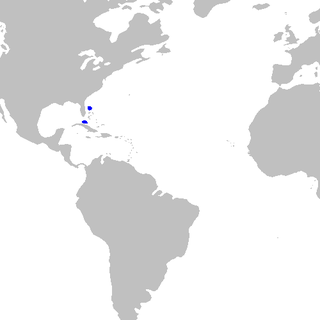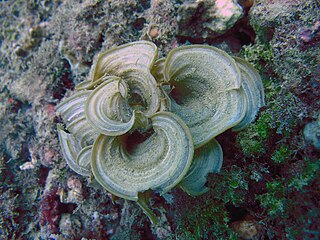
Kelps are large brown algae or seaweeds that make up the order Laminariales. There are about 30 different genera. Despite its appearance, kelp is not a plant but a stramenopile, a group containing many protists.

Brown algae are a large group of multicellular algae comprising the class Phaeophyceae. They include many seaweeds located in colder waters of the Northern Hemisphere. Brown algae are the major seaweeds of the temperate and polar regions. Many brown algae, such as members of the order Fucales, commonly grow along rocky seashores. Most brown algae live in marine environments, where they play an important role both as food and as a potential habitat. For instance, Macrocystis, a kelp of the order Laminariales, may reach 60 m (200 ft) in length and forms prominent underwater kelp forests that contain a high level of biodiversity. Another example is Sargassum, which creates unique floating mats of seaweed in the tropical waters of the Sargasso Sea that serve as the habitats for many species. Some members of the class, such as kelps, are used by humans as food.

A sawshark or saw shark is a member of a shark order bearing a unique long, saw-like rostrum edged with sharp teeth, which they use to slash and disable their prey. There are eight species within the Pristiophoriformes, including the longnose or common sawshark, shortnose sawshark, Japanese sawshark, Bahamas sawshark, sixgill sawshark, African dwarf sawshark, Lana's sawshark and the tropical sawshark.

Lobata is an order of transparent marine invertebrates belonging to the phylum of Ctenophora in the class Tentaculata, and are commonly referred to as comb jellies or sea gooseberries. There are currently 19 extant known species in the order of Lobata. Members of Lobata exhibit a compressed body in the vertical plane and a pair of oral lobes. They are known to inhabit marine pelagic surfaces and the marine shores.

Laminaria is a genus of brown seaweed in the order Laminariales (kelp), comprising 31 species native to the north Atlantic and northern Pacific Oceans. This economically important genus is characterized by long, leathery laminae and relatively large size. Some species are called Devil's apron, due to their shape, or sea colander, due to the perforations present on the lamina. Others are referred to as tangle. Laminaria form a habitat for many fish and invertebrates.

Camellia japonica, known as common camellia, or Japanese camellia, is a species of Camellia, a flowering plant genus in the family Theaceae. There are thousands of cultivars of C. japonica in cultivation, with many colors and forms of flowers. Despite its common name, it is native to China, not Japan. The cultivation of Camellia japonica also started in China. Its widespread cultivation can be traced back to the Song Dynasty, when 15 varieties of Camellia japonica were recorded in literature. It was later introduced to Japan. It grows in forests, at altitudes of around 300–1,100 metres (980–3,600 ft).

The Bahamas sawshark, Pristiophorus schroederi, is a sawshark of the family Pristiophoridae, found in the western Central Atlantic Ocean from the Bahamas and Cuba at depths of between 400 and 1,000 m. These sharks are at least 80 cm long.

The Japanese angelshark is a species of angelshark, family Squatinidae, found in the northwestern Pacific Ocean off China, Japan, and Korea. It is a bottom-dwelling shark found in sandy habitats down to 300 m (980 ft) deep. This species has the flattened shape with wing-like pectoral and pelvic fins typical of its family, and grows to 1.5 m (4.9 ft) or more in length. Its two dorsal fins are placed behind the pelvic fins, and a row of large thorns occurs along its dorsal midline. Its upper surface is cryptically patterned, with numerous squarish dark spots on a brown background.

Padina pavonica, commonly known as the peacock's tail, is a small brown alga found in the Indian Ocean, the Pacific Ocean, the Atlantic Ocean and the Mediterranean Sea. It inhabits pools in the littoral zone typically with clayey, silty or sandy sediments. Other habitats include rocks and shell fragments in the shallow sublittoral, seagrass meadows, mangrove roots and coral reefs on tidal flats.

The Indonesian angelshark is a rare species of angelshark, family Squatinidae, known only from a few specimens collected from fish landing sites in southern Indonesia. It is thought to inhabit the deep waters of the continental slope. Reaching at least 1.34 m (4.4 ft) long, this species has a flattened, ray-like shape and a well-developed tail and caudal fin. It is characterized by the absences of fringes on its nasal barbels and thorns down the midline of its back, as well as by its relatively plain grayish-brown dorsal coloration with dark saddles beneath the dorsal fin bases and a black leading margin on the underside of the pectoral fins. The International Union for Conservation of Nature (IUCN) has classified it as Critically Endangered due to significant fishing pressure.

The Japanese sleeper ray is a species of electric ray in the family Narkidae. It is common in the inshore and offshore waters of the northwestern Pacific Ocean from southern Japan to southern China. Growing up to 40 cm (16 in) long, the Japanese sleeper ray has a nearly circular pectoral fin disc colored reddish to chocolate brown above, sometimes with darker or lighter spots, and lighter brown below. The spiracles behind its small eyes have raised, smooth rims. Its short and muscular tail bears a single dorsal fin positioned aft of the rounded pelvic fins, and terminates in a large caudal fin.

Brachysomophis cirrocheilos, also known as the stargazer snake eel, is a benthic marine fish belonging to the family Ophichthidae. The stargazer snake eel is a large fish which grows up to 159 cm (63 in) long.
Perophora japonica is a species of colonial sea squirt in the genus Perophora, native to the North Indo-Pacific. It has spread to several other parts of the world including the south coast of Britain, France, the Netherlands and the west coast of the United States.

Calotomus carolinus, commonly known as Carolines parrotfish, is a species of marine ray-finned fish, a parrotfish, in the family Scaridae. It is also known as the starry-eye parrotfish, stareye parrotfish, bucktooth parrotfish, Christmas parrotfish or marbled parrotfish. Since the Calotomus carolinus is known across the Pacific, it also has its own name in many native languages for example, it is called a panuhunuhunu in the Hawaiian language.

Babylonia japonica, common name the Japanese Babylon or Japanese ivory shell, is a species of sea snail, a marine gastropod mollusc in the family Babyloniidae.

Padina boergesenii, commonly known as the leafy rolled-blade alga, is a species of small brown alga found in the tropical and subtropical western Atlantic Ocean, the Mediterranean Sea, and the Pacific Ocean. This seaweed was named in honour of the Danish botanist and phycologist Frederik Børgesen.

Padina is a genus of brown macroalgae in the family Dictyotaceae.
Padina sanctae-crucis is a species of brown macroalgae in the family Dictyotaceae. It is a tropical brown algae species native to the south pacific that belongs to the Padina genus. this alga includes sexual reproduction and spore-producing asexual reproduction which is moved with the tide until spores plants itself on a hard rocky substrate. Other habitats include rocks and shell fragments in the shallow sublittoral, seagrass meadows, mangrove roots and coral reefs on tidal flats.
Crosslandia daedali is a species of sea slug within the family Scyllaeidae, found in subtropical waters in the Eastern Central Pacific Ocean in Mexico and Costa Rica. It lives in benthic environments, usually on algae within the genus Padina where it grazes on small hydroids.

Scolopsis japonica, the Javan monocle bream or whitecheek monocle bream, is a species of marine ray-finned fish belonging to the family Nemipteridae, the threadfin breams. This fish is found in the western Pacific Ocean.
















